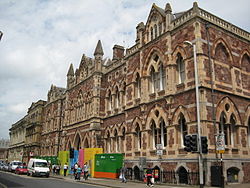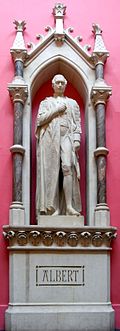Royal Albert Memorial Museum
| The Royal Albert Memorial Museum | |
|
Devon | |
|---|---|
 The Royal Albert Memorial Museum | |
| Type: | museum |
| Location | |
| Grid reference: | SX91949283 |
| Location: | 50°43’30"N, 3°31’56"W |
| City: | Exeter |
| History | |
| Address: | Queen Street |
| Built 1868 | |
| By: | John Hayward |
| museum | |
| Gothic Revival | |
| Information | |
| Owned by: | Exeter City Council |
| Website: | Royal Albert Memorial Museum |
The Royal Albert Memorial Museum and Art Gallery is a museum and art gallery in the City of Exeter, the county town of Devon. It is the largest museum in the city, holding significant and diverse collections in areas such as zoology, anthropology, fine art, local and overseas archaeology, and geology.
Altogether the museum holds over one million objects, of which a small percentage is on permanent public display.
Founded in 1868, the museum is housed in an impressive Gothic revival building of local new red sandstone on Queen Street in the heart of the city. The building has undergone several extensions during its history; most recently, the museum was re-opened in December 2011 after a redevelopment lasting four years and costing £24 million.
History

Establishment and early period
The site for the museum was donated by Richard Sommers Gard, MP for Exeter from 1857 to 1864, and a competition for its design attracted 24 entries, including one from John Hayward, whose gothic design was the winner.[1] His original plan called for a tall central tower like that at the Oxford University Museum of Natural History, but that feature was rejected and was replaced by a gable and rose window.[2]
The museum was initially proposed by Sir Stafford Northcote as a practical memorial to Prince Albert, and an appeal fund was launched in 1861. John Gendall volunteered to curate an initial collection required to fill the planned building.[3] and the first phases of the building were completed by 1868. the museum was the birthplace for much of Exeter's cultural life - the university, central library and college of art all had their origins in what became known as the Royal Albert Memorial Museum: The 'Devon and Exeter Albert Memorial', as it was originally known, provided an integrated museum, art gallery, free library, reading room, school of art and school of engineering in the manner long advocated by Prince Albert.
The contents of the Memorial soon outgrew the building, necessitating the construction of extensions in 1894 (by Medley Fulford) and in 1898 (by Tait and Harvey).[1] This second extension, the York Wing, was opened by the Duke and Duchess of York, later King George V and Queen Mary, and at the same time the title of 'Royal' was granted and so from that date the name Royal Albert Memorial Museum was used. Over the course of time locals adopted the abbreviation 'RAMM', and this in turn became the name by which the museum is branded.
| “ | An exquisite jewel box of a building; a Venetian casket. One of the most appealing treasures in Britain. | ” |
For many years the museum changed little after that construction period, although the city library moved out of the museum in 1930, the school of science ultimately developed into the University of Exeter and the school of art became what is now the University of Plymouth's Faculty of Art & Education, formerly Exeter College of Art and Design. Over time the museum gradually expanded to fill the whole building.
The museum today
Between 2007-11 a major redevelopment was completed costing £24 million. Designed by architects Allies and Morrison,[5] it included repair to the fabric of the building, refurbishment, a complete redisplay of the collections, an extension and a new entrance from the historic Registered gardens at the rear. In addition a purpose-built off-site collections store called the Ark was built and fitted out. [6] The museum reopened on 15 December 2011.
Collections
Four major collection areas are represented: antiquities, art, natural history and world cultures. The world cultures collections are designated as being of national and international significance by the government.

The museum's zoology collection includes specimens of invertebrates and mammals from across the world. Percy Sladen's collection of echinoderms is held by the museum and considered the most important of its kind outside of any national collection.[7]
The costume and textiles collection of the museum is considerable; according to the University of Brighton, they "must rank as one of the most important collections outside London".[8] Due to the delicate nature of these materials, the collection is not on permanent display.[9]
The museum's art collection comprises over 7,000 objects including paintings, drawings, prints and sculpture, representing important British artists and emphasising the museum's location in the West Country. Significant artists represented in the collection include Gainsborough, Reynolds, Pompeo Batoni, Richard Wilson and Joseph Wright of Derby; Walter Sickert, Barbara Hepworth, John Nash, Edward Burra, David Bomberg and Patrick Heron.
The donors who contributed to the collection include Kent Kingdon (an upholsterer and interior designer), Sir Harry Veitch (owner of the horticultural firm Veitch and Sons) and John Lane (founder of the publishing firm The Bodley Head). [1]
Awards and recognition
the museum was named the United Kingdom's "Museum of the Year" by The Art Fund charity in 2012, citing its "ambition and imagination".[10]
Since reopening, the museum has won over a dozen other awards, including three regional awards from the Royal Institute of British Architects in 2013; [11] the Collections Trust award recognising the curatorial and collections management good practice of the museum (2013);[12] and the American Event Design Award for Best Museum Environment (2012).[13]
Veitch Memorial Lecture
At the end of every July, the Royal Albert Memorial Museum holds a plant-orientated lecture in memory of Sir Harry Veitch.[14]
Outside links
| ("Wikimedia Commons" has material about Royal Albert Memorial Museum) |
References
- ↑ 1.0 1.1 Meller, Hugh: 'Exeter Architecture' (Phillimore, 1989) pages 79–80 ISBN 0-85033-693-7
- ↑ Nikolaus Pevsner: The Buildings of England: Devon, 1952; 1989 Penguin Books ISBN 978-0-300-09596-8page 402
- ↑ John Gendall, OxfordArtOnline, retrieved 29 October 2013
- ↑ About The Royal Albert Memorial Museum
- ↑ 'Designing RAMM' - The Royal Albert Memorial Museum
- ↑ "Exeter City Council – Our Redevelopment". 2010. http://www.rammuseum.org.uk/Our-Redevelopment/. Retrieved 14 January 2010.
- ↑ Rowe, F. W. E. (1 September 1974). "Catalogue of the Sladen Collection in the Royal Albert Memorial Museum, Exeter, Devon". Biological Journal of the Linnean Society 6 (3): 179–243. doi:10.1111/j.1095-8312.1974.tb00722.x.
- ↑ "The Royal Albert Memorial Museum and Art Gallery, Exeter and Killerton House Dress Collections". University of Brighton. Archived from the original on 18 November 2013. https://web.archive.org/web/20131118034605/http://arts.brighton.ac.uk/study/history-art-design/dress-collective/listing-of-dress-collections/the-royal-albert-memorial-museum-and-art-gallery%2C-exeter-and-killerton-house-dress-collections. Retrieved 19 May 2013.
- ↑ "Costume and textiles". Royal Albert Memorial Museum. http://www.rammuseum.org.uk/collections/costume-and-textiles. Retrieved 19 May 2013.
- ↑ "Exeter's Royal Albert Museum wins Art Fund prize". BBC News. http://www.bbc.co.uk/news/entertainment-arts-18509116. Retrieved 19 June 2012.
- ↑ "RIBA South West Awards". RIBA. http://www.designengine.co.uk/riba-south-west-awards/. Retrieved 3 July 2016.
- ↑ "OpenCulture 2013". Collections Trust. Archived from the original on 2 February 2016. http://webarchive.nationalarchives.gov.uk/20160202150805/http%3A//www.collectionstrust.org.uk/events/past%2Devents/item/1475%2Dopenculture2013. Retrieved 3 July 2016.
- ↑ Event Design Awards – Royal Albert Memorial Museum
- ↑ Veitch Nursey
